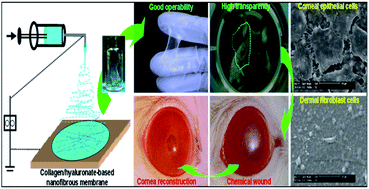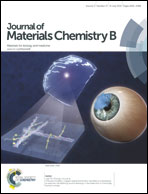Chitosan-modified, collagen-based biomimetic nanofibrous membranes as selective cell adhering wound dressings in the treatment of chemically burned corneas†
Abstract
Corneal chemical injury is a general but intractable ocular emergency, the sequelae of which are particularly challenging to treat. Human amniotic membrane (HAM) is one of the resources as a wound dressing for damaged corneal reconstruction, but the concerns related to the possible transmission of infectious diseases are the main drawbacks. Here we present a versatile method utilizing electrospinning and surface modification processes to develop optically highly transparent, microstructurally stable (>20 MPa in tensile strength in the wet state) biomimetic nanofibrous membranes. These membrane nanofibers, mainly consisting of a collagen–hyaluronate interior and a chitosan surface coating, showed superior mechanical and biological performances compared to HAM, and were favorable to the selective adhesion of epithelial cells (corneal, conjunctival) and fibroblasts. The alkali-burned corneal damage model in rats demonstrated that the biomimetic membranes could markedly improve re-epithelialization in corneal tissue within one week. Therefore, such bioactive multifunctional membranes may find widespread biomedical applications in wound healing and postoperative anti-adhesion in the near future.


 Please wait while we load your content...
Please wait while we load your content...